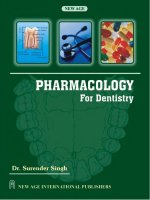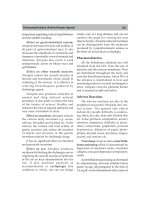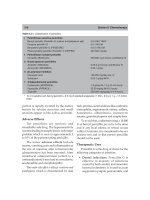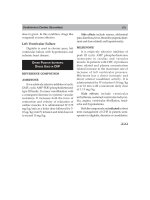Pharmacology for dentistry phần 91
Bạn đang xem bản rút gọn của tài liệu. Xem và tải ngay bản đầy đủ của tài liệu tại đây (53.27 KB, 5 trang )
438
Tetanus is an infection caused by a
bacteria found in dirt, gravel and rusty
metal. It usually enters the body through a
cut. Tetanus bacteria causes the muscles to
spasm (move suddenly). If tetanus attacks
the jaw muscles it causes lockjaw, the
inability to open the mouth. Tetanus can
also cause spasm of the respiratory muscles,
which can be fatal.
Pertussis also called whooping cough
which is caused by a bacteria that clogs the
lungs with mucus (a thick, slimy
substance). This can cause a severe cough
that sounds like a ‘whoop.’ The cough can
last for two months and allows the infection
by other bacteria which can cause
pneumonia and bronchitis (infection of
lungs).
Diphtheria Antitoxin
It is used for passive immunisation in
suspected cases of diphtheria and should
be given without waiting for bacteriological
confirmation of the infection and
antibacterial agent is usually given
concomitantly. A test dose of diphtheria
antitoxin should always be given to test
hypersensitivity.
COMBINATION VACCINE
A combination vaccine consists of two
or more separate immunogens physically
combined in a single preparation. A
combination vaccine gives protection from
more than one disease.
Advantages of Combination Vaccines
• It is more convenient for parents and
medical staff since number of visits to
the hospital are reduced.
Section 13/ Miscellaneous
• It is less traumatic for children since
lesser number of injections have to be
given.
• Combined vaccines invariably cost less
than the sum of their component
individual vaccines.
• The overall number of adverse
reactions is lower.
• The chance of compliance is increased
benefitting the individual and the
community.
• There is more cost-effective use of
health-care manpower and resources.
• The cost of purchase, transportation
and storage of vaccines are
substantially reduced.
• The administration of medical records
and vaccine scheduling is simplified.
Some examples of combination
vaccines include DTP, MMR etc. Now,
newer combination vaccines are available
that provide prevention against four
diseases (DTP + HB) or even five diseases
(DTP + HB/Hib) making it pentavalent
vaccine.
COMBINATION VACCINES WITH
HAEMOPHILUS B CONJUGATE VACCINE (HIB TITER)
Each lyophilisate for one immunising dose
of diphtheria, tetanus toxoids and pertussis
with Haemophilus b conjugate vaccine
contains Haemophilus influenzae type b
polysaccharide conjugated to tetanus protein
10 mcg, purified diphtheria toxoid 1
immunising dose, purified tetanus toxoid 1
immunising dose, Bordetella pertussis
minimum of 4.1 IU.
It is indicated in all children from age
of two months onwards for the combined
Vaccines, Sera and Other Immunological Agents
prevention of invasive infections such as
meningitis, septicaemia, epiglottitis etc.
caused by Haemophilus influenzae type b,
diphtheria, tetanus and pertussis.
Dosage: Three injections of 0.5 ml at
one or two months interval followed by a
booster injection administered one year
after the primary vaccination.
DUAL ANTIGEN
It is a uniform suspension of diphtheria
and tetanus toxoid adsorbed on aluminium
phosphate and suspended in isotonic saline
solution.
Adverse effects include mild local
reactions like pain, redness, tenderness at
the site of injection. Mild to moderate
transient fever and irritability.
It is used for active immunisation of
children against diphtheria and tetanus in
cases where it is decided not to immunize
against pertussis also.
Dosage: 3 IM injections of 0.5 ml to be
administered with an interval of four to
eight weeks between doses. A fourth
injection of 0.5 ml should be administered
one year after initial injection.
HEPATITIS B (BEVAC)
Hepatitis B is a worldwide disease
caused by the hepatitis B virus (HBV). HBV
primarily affects the liver inducing an
inflammatory reaction that destroys liver
cells and often hinders liver function. The
consequences of infection are variable and
unpredictable. They depend on the age and
immunity status of the patient.
The hepatitis B virus is highly infectious.
It is estimated to be 100 times more
439
infectious than HIV which causes AIDS.
Hepatitis B kills more people in a day than
AIDS kills in a whole year.
Blood is the most important vehicle for
transmission but other body fluids have
also been implicated including semen,
vaginal secretions and saliva.
HBV can spread in three ways: From
mother to child (MTC), at birth and from
person to person.
Hepatitis B vaccine is used for active
immunisation against hepatitis B infection.
Immunisation should be considered in
persons at high risk of contracting hepatitis
B.
Adverse effects include mild transient
soreness and induration at injection site.
Occasionally low grade fever, malaise,
fatigue, headache, nausea and dizziness.
It is used for active immunization
against hepatitis B virus infection.
Dosage:
• Adults: 1 ml by IM injection into the
deltoid muscle; repeated one month
and six months later.
• Children: 0.5 ml by IM injection into the
anterolateral aspect of thigh; repeated
one month and six months later.
Administration: This is for IM use only.
In adults the injection should be given in
the deltoid region; in neonates and infants
the injection should be
given in
anterolateral thigh. Dose for adults and
children above 10 years is 20 mcg and for
neonates, infants and children below 10
years the dose is 10 mcg. Three doses are
given as above. For rapid immunization the
Section 13/ Miscellaneous
440
third dose can be given two months after
the first dose and a fourth booster dose at
12 months.
HEPATITIS A (AVAXIM)
Hepatitis A is one of the most
widespread infectious diseases worldwide.
It is caused by the hepatitis A virus and is
common in places with poor standards of
hygiene and sanitation. The virus attacks
the liver and causes varying degrees of
illness in patients.
The hepatitis A virus is excreted in the
faeces. Direct contact with an infected
person’s faeces or indirect contamination of
food, water, hands and cooking utensils may
result in the virus being ingested, causing
infection.
Symptoms include nausea, vomiting,
jaundice (yellowness of eyes, skin and
urine), diarrhoea, pale stools, abdominal
pain, malaise, fatigue, fever, chills, lack of
appetite, sore throat, etc.
Hepatitis A is often confused with
hepatitis B. What is important to remember
is that hepatitis A is the single largest cause
of jaundice. Also vaccination against hepatitis
B does not protect from hepatitis A.
hepatitis A is an occupational hazard or in
whom there is an increased risk of
transmission (persons working in a day care
centre, nursing, medical and paramedical
personnel especially gastroenterology and
paediatric unit, sewage workers,
homosexuals, haemophilia patients, abusers
of injectable drug and persons with multiple
sexual partners.
Adverse effects include injection site
soreness, redness and swelling; mild
headache, malaise, fatigue, fever, nausea
and loss of appetite.
Dosage:
• Adults (19 years onwards): A single
dose of hepatitis A adults vaccine (1
ml suspension containing not less than
1,440 ELISA units of viral antigen) is
used for primary immunization.
• Children and adolescents (from 1 year
up to 18 years of age): A single dose
of hepatitis A junior vaccine (0.5 ml
suspension containing not less than
720 ELISA units of viral antigen) is
used for primary immunization.
In both a booster dose is recommended
any time between 6 to 12 months later to
ensure long time protection from hepatitis A.
A vaccine is now available and is the
most practical means of protection against
hepatitis A. A complete course of vaccine
should be taken to get long term protection.
Administration: By IM route only, in
deltoid muscle.
Hepatitis A vaccination is indicated for
active immunisation against hepatitis A virus
(HAV) infection in subjects at risk of exposure
to HAV such as travellers to high prevalence
areas, armed force personnel travelling to
high endemic areas, person in whom
Typhoid fever is a disease which starts
as an infection of the gastrointestinal tract.
It is caused by the bacterium Salmonella
typhi. It spreads by ingestion of
contaminated food or drink. Normally
Salmonella typhi bacterium is inactivated by
TYPHOID (TYPHIVAX)
Vaccines, Sera and Other Immunological Agents
acid in stomach. However, if a large
number of bacteria are ingested, a
substantial number may reach the small
intestine. Symptoms include periodic fever,
headache, tiredness and weakness, changes
in behaviour and abdominal discomfort
with constipation in the early stages of the
disease followed by diarrhoea later.
Typhoid vaccines are used for active
immunisation against typhoid fever. Two
types of vaccine, one injectable and other
oral are available.
Polysaccharide Typhoid Vaccine
It is prepared from Vi capsular
polysaccharide of Salmonella typhi.
Immunity develops 7 to 15 days after
injection and protection lasts for three
years.
Adverse effects include slight local
pain, fever and rash.
It is indicated for prevention of typhoid
fever in adults and children over five years.
Dosage: Single dose of 0.5 ml SC or IM.
Oral Typhoid Vaccine
It contains the attenuated strain Ty21a
of Salmonella typhi. The attenuation is due
to the absence of enzyme uridine
diphosphate galactose-4-epimerase which
is essential for the production of the
lipopolysaccharide ‘O’ antigen. The
absence of this enzyme makes Ty21a highly
immunogenic.
Adverse effects include fever and/or
mild GI effects.
It is indicated for prophylactic
immunization of adults and children over
six years against typhoid fever.
441
Dosage: One capsule on day 1, 3 & 5
irrespective of age and weight.
HIB (H. INFLUENZAE TYPE B;
VAXIGRIP)
Haemophilus influenzae is a bacteria
which exists in many forms. The type B
form called Hib, commonly produces
disease in humans by colonizing the upper
respiratory tract of up to 80 percent of the
population and is major cause of infection
and mortality in children.
Almost all Hib disease occurs in
children younger than five years and
mostly in children younger than one year.
Transmission of Hib from one individual
to another primarily occurs via respiratory
secretions from carriers. However, Hib can
also be spread through direct contact with
a person with Hib disease but this accounts
for only two percent of cases in children
younger than four years old.
The manifestations of Hib disease are
varied with the most serious being
meningitis and epiglottitis.
Adverse effects include mild and
transient local erythema, swelling, fever,
irritability, sleepiness, GIT disturbances,
rashes and anorexia.
It is indicated for immunisation of
children against invasive disease caused by
Haemophilus influenzae type b (meningitis,
septicemia, cellulitis, arthritis, epiglottitis).
The safety and efficacy of Hib vaccines
have clearly been demonstrated in
developed countries and their introduction
into the national vaccination programme
of developing countries in the future can
markedly reduce the incidence of Hibrelated disease worldwide.
442
MMR (MEASLES, MUMPS &
RUBELLA; TRESIVAC)
Measles
In developing countries, measles can be
a very severe disease, with mortality rates
as high as 10 percent. Hence, vaccination
is recommended for all children at the
earliest possible age. Currently, the WHO
recommended nine months as the age for
measles vaccination, taking into account
maternal antibody levels and vaccine intake,
as well as disease incidence.
The signs and symptoms of measles
include fever, common cold-like symptoms,
conjunctivitis, cough, spots inside the mouth
and a skin rash. Diarrhoea, stomach pain
and loss of appetite may also be present.
The severity of the symptoms of measles
is greater in adolescents and adults than in
children. The incubation period is 10 to 12
days and during this period there is virtually
no outward sign of illness. During this
period the virus first causes a local infection
of the upper respiratory tract then spreads
to other parts of the body. The virus is then
disseminated throughout by bloodstream
causing a primary disease.
Mumps
Mumps or infective parotitis is an acute
infectious disease usually marked by a
painful enlargement of one or both salivary
glands around the jaw. In addition,
dryness of the mouth may often occur.
Rubella
Rubella or German measles, is a highly
infectious disease, which mostly affects
children, adolescents and young adults.
Section 13/ Miscellaneous
Rubella soon after birth is a disease which
is usually trivial and of short duration. Its
most obvious sign is a mild rash. Rubella
virus infection during pregnancy can
disrupt fetal growth and cause birth defects.
Approximately 25 to 50% of rubella infections may go undetected. When symptoms do present, they are usually quite mild.
Adults who contract rubella present
with fever and loss of appetite for two days
prior to the onset of the rash.
MMR Vaccination
Live attenuated virus vaccines for
measles, mumps and rubella (MMR) have
been combined into a single vaccine known
as MMR vaccine. The MMR vaccine is
effective as the single-virus vaccine
composed of the respective strains and has
been shown to be highly effective. The
immunity induced by MMR is long lasting
and may be lifelong.
Adverse effects include hyperthermia,
rhinopharyngeal or respiratory symptoms of
short duration. Hyperthermia convulsions
are rarely observed. Lymphadenopathies or
parotitis may be observed.
It is indicated for joint prevention of
measles, mumps and rubella, normally, given
from the age of 12 months, in infants of both
sexes.
CHICKENPOX (VARICELLA; OKAVAX)
Chickenpox or varicella is caused by the
varicella zoster virus (VZV). Varicella
vaccine is indicated for active immunisation
against varicella in healthy subjects and
their susceptible healthy close contacts
from the age of 12 months onwards.









